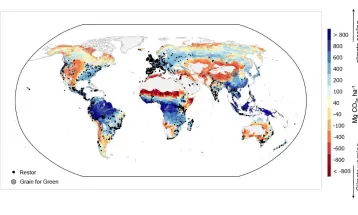New research shows: More than 80% of Restor sites are in places that can cool the planet

By Susan Cook-Patton, Senior Forest Restoration Scientist at The Nature Conservancy and Member of the Science Advisory Board at Restor
There is a growing recognition among scientists, policymakers and the general public that biodiverse forests have an indispensable role in addressing global challenges like climate mitigation and adaptation, protecting biodiversity and enhancing human well-being. New science from Clark University, The Nature Conservancy, and ETH Zurich shows that more than 80% of the restoration sites on Restor are in places where restoring tree cover can have a net cooling effect on the planet. Importantly, choosing the right location for restoring tree cover is key. As trees grow, they can pull carbon out of the atmosphere and lock it into wood and soil. However, restoring tree cover also alters what is known as albedo. Albedo is the amount of sunlight reflected back into space from the Earth’s surface. Some land covers reflect a lot of light, such as grasslands or snow covered landscapes. In contrast, the dark colour of tree leaves can lead to greater absorption of sunlight, which can cause warming and reduce the positive effect of carbon drawdown. “The incredible thing about nature is that it buffers the external temperatures. So it has a vital cooling effect where the weather is too hot. And it has a warming effect in freezing regions which can be so beneficial for local biodiversity.” Co-author Dr. Thomas Crowther, Founder Restor. Sometimes, restoring tree cover can worsen the climate crisis due to changes in albedo. In certain areas, warming caused by changes in albedo can outweigh the cooling from carbon removal. However, the data collected by Restor shows an encouraging trend. The scientists identified that the vast majority of restoration projects steer clear of these climate-negative zones. Instead, they occur in places that help to cool the planet. This finding underscores the connection that restoration efforts led by local communities have a positive impact on climate mitigation and adaptation. The availability of precise data on the locations of restoration and conservation sites worldwide, made possible for the first time through platforms like Restor, marks a significant milestone for the field of restoration. This newfound capability revolutionises the kinds of questions researchers can ask, and offers unprecedented insights into the effectiveness of restoration efforts. As the climate crisis heats up, we need to ensure that climate funds are spent as effectively as possible. The study provides a series of maps that can help anyone, anywhere determine how much albedo change affects their project to restore tree cover. Indeed most of the Restor sites were impacted by changes in albedo to some degree, indicating that albedo almost always needs to be considered in the climate accounting ledger. However, it is encouraging to see that so many of the sites on Restor are positioned to help cool the planet.

Restor is the world’s largest collection of community-led restoration and conservation projects. Since all Restor sites are run by local communities, this shows just how important community-led restoration efforts are for climate mitigation. And restoring trees does more than simply pull carbon out of the atmosphere, it benefits biodiversity and the well-being of local communities around them. Supporting community-led initiatives is thus key to achieving a more sustainable future for people and biodiversity.